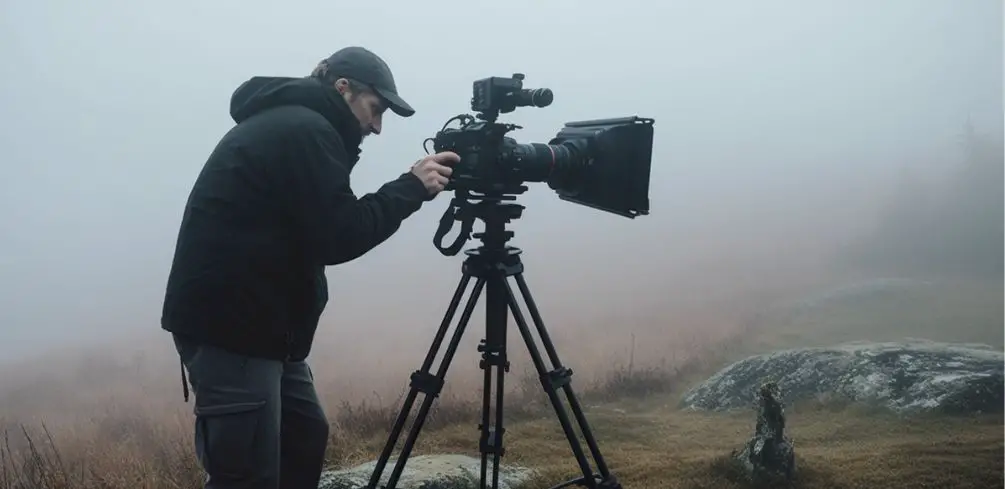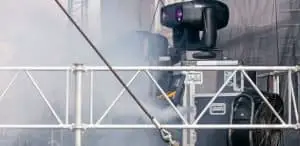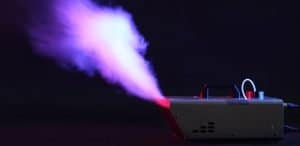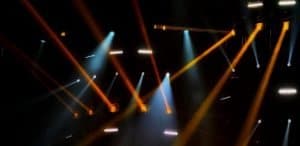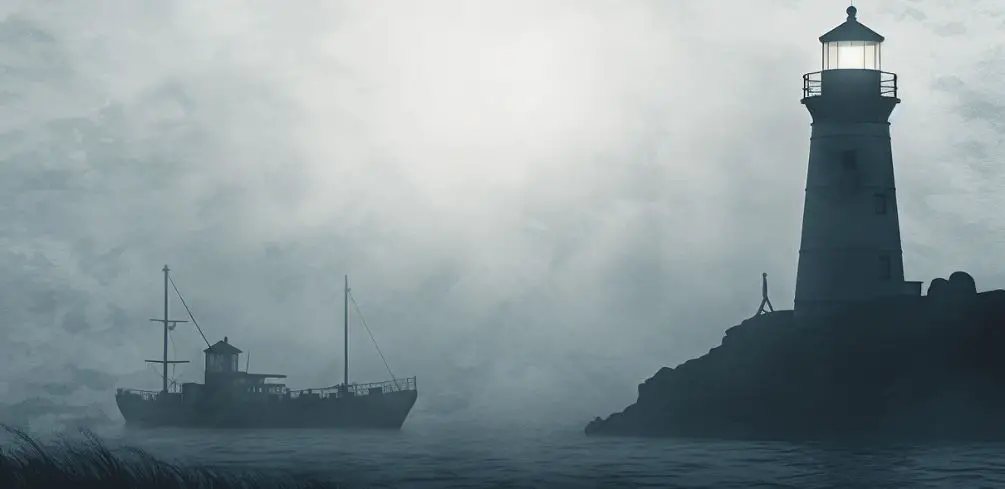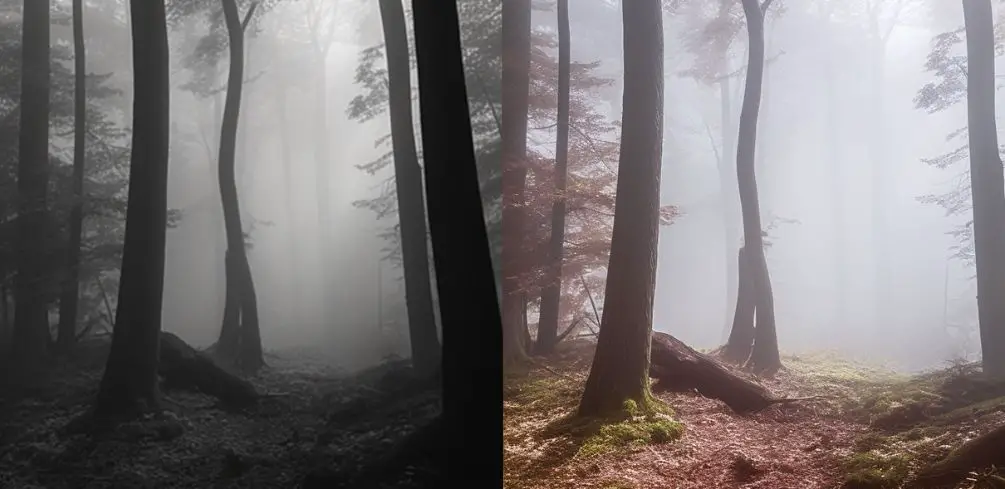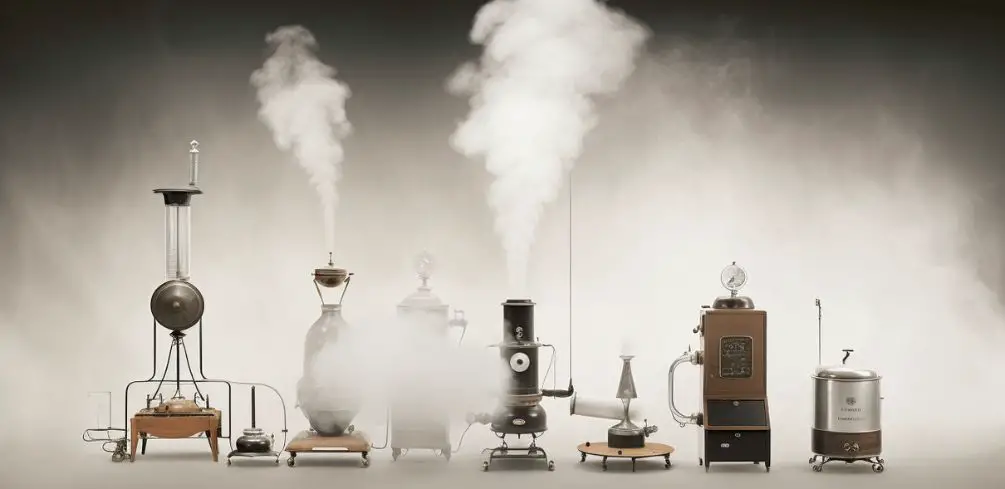Imagine yourself standing in a serene landscape, shrouded in a mysterious fog that seems to transform the world around you into an ethereal dreamscape. You feel an irresistible urge to capture this moment through your camera lens or film reel.
But how do you truly convey the magic of fog in your photography and filmmaking? Fear not, for we have assembled a treasure trove of tips and tricks to help you master the art of capturing foggy scenes.
Understanding Different Types of Fog

Diving into the world of misty landscapes, it’s essential to grasp the various kinds of fog that can transform your shots and scenes into ethereal masterpieces. Fog formation is influenced by temperature, humidity, and topography, leading to distinct fog densities, colors, patterns, and persistence.
By understanding these differences and how they interact with light sources or subjects in your frame, you’ll be well-equipped to harness the enchantment of foggy environments.
There are several types of fog formations you may come across during your photographic endeavors. Radiation fog forms when the ground cools down at night, causing moisture in the air above to condense; this type generally dissipates when warmed by morning sunlight.
Advection fog occurs when warm moist air passes over a colder surface like water or snow-covered ground; it often appears near coastlines with consistent winds. Valley fog collects in low-lying areas surrounded by hills or mountains due to cold air sinking overnight; this creates dense pockets of fog that linger longer than other types.
Each type offers unique opportunities for creating dream-like images while challenging your skills in capturing light through varying densities and persisting conditions. Take note of how different hues emerge within the depths of shifting mists—fog colors can range from cool blue tones in early mornings or late evenings to warmer golds as sunlight filters through during sunrise or sunset hours.
Fog patterns come alive as swirling wisps dance around trees, buildings, or other foreground elements, adding a sense of movement and depth to your compositions.
Embrace these ever-changing elements as they work their magic on camera sensors – transforming ordinary landscapes into breathtaking vistas filled with mystery and intrigue. As you continue exploring the realm of photography enveloped by shrouds of mist, remember that mastering various types of fogs will ultimately help elevate your artistic vision.
Seek out those rare moments where nature’s veil descends upon familiar scenes – opening up new dimensions for visual storytelling and creative expression.
Mastering Exposure and Focus in Foggy Conditions

Navigating the mystical haze of exposure and focus amidst a foggy scene can be both enchanting and challenging, but we’ll unveil the secrets to mastering these elements with ease.
Capturing the perfect shot in foggy conditions requires a delicate balance of technical skills and artistic flair. To begin with, let’s explore the world of foggy shutter speeds: slowing down your shutter speed will allow more light to enter your camera, creating an ethereal glow that enhances the atmosphere of your photograph.
Meanwhile, white balance adjustments are crucial for rendering accurate colors amidst the ever-changing hues of fog; experimenting with different settings will help you find the perfect harmony between coolness and warmth.
Diving deeper into this mist-filled realm, you’ll discover that maintaining proper focus is essential to achieving crisp images despite reduced visibility. Mastering depth of field manipulation allows you to control which portions of your image are sharp or soft, generating captivating shots that draw viewers into their dreamy embrace.
Pay special attention to foggy lens care: moisture buildup on your lens can lead to decreased contrast and clarity in your photos, so keep a microfiber cloth handy for quick cleaning sessions during those humid shoots.
As you venture further into this photographic wonderland, it’s vital to ensure that your equipment remains protected against inclement weather conditions. Weather-sealing essentials such as waterproof covers or bags safeguard your gear from moisture damage and provide peace of mind so you can focus solely on capturing awe-inspiring images amid swirling mists.
By combining these techniques – adjusting shutter speeds and white balance settings, expertly manipulating depth-of-field, caring for lenses in misty environments, and investing in weatherproof protection – you’ll become a master at navigating through enchanting fog-filled landscapes while wielding photography’s magic wand with confidence.
Composition Techniques for Capturing Fog

In this section, we’ll delve into the art of composing captivating shots in foggy conditions, ensuring that your images evoke a sense of mystery and allure.
Foggy reflections can create an ethereal atmosphere as they mirror the world above them, inviting viewers to question their perspective. Silhouetting subjects against a foggy backdrop is another powerful technique; it accentuates your subject’s shape and form while evoking feelings of mystery and intrigue.
Layered landscapes work wonders in fog as well—the layers subtly emerge from the haze, giving depth to your images while maintaining an air of mystique.
Minimalist compositions thrive in foggy settings by emphasizing simplicity and allowing negative space to speak volumes. These compositions often rely on one or two strong elements standing out against a diffused background, resulting in a striking scene that captivates your audience.
High-contrast scenes are another fantastic option for creating compelling imagery in less-than-ideal visibility conditions. By isolating bold shapes or patterns against the softness of the fog, you can produce eye-catching visuals that demand attention.
Remember to experiment with different composition techniques when capturing photos or filming in foggy environments—there’s no one-size-fits-all approach! Embrace the unique qualities of each setting and let yourself be guided by your creative instincts.
By incorporating these methods—foggy reflections, silhouetting subjects, layered landscapes, minimalist compositions, and high-contrast scenes—, you’ll transform ordinary scenes into extraordinary works of art that leave lasting impressions on those who experience them. So go ahead and immerse yourself in the magic of fog; there’s no limit to what you can achieve with these tips at hand!
Utilizing Fog for Mood and Atmosphere

You’ll find that harnessing the power of fog can dramatically enhance the mood and atmosphere in your visual creations, making them both captivating and unforgettable.
Foggy emotions can evoke a variety of feelings, from mystery and intrigue to melancholy and isolation. Atmospheric storytelling allows you to use fog as a powerful tool in your photography and filmmaking toolkit, setting the stage for unforgettable narratives.
- Fog props: Utilize artificial fog machines or dry ice to create dense layers of fog that envelop your subjects or scenes, adding depth and visual interest.
- Color psychology: Experiment with different color temperatures in your lighting to further enhance the mood created by the fog; for example, cool blue tones can evoke feelings of eeriness or sadness while warm amber hues may suggest nostalgia or romance.
- Foggy silhouettes: Play with backlighting techniques behind your subject or scene to create striking silhouettes shrouded in mist, becoming an iconic image that lingers in viewers’ minds.
Remember that achieving the perfect balance between fog density and visibility is essential when utilizing it for mood and atmosphere. Too much fog might obscure important elements within your frame while too little may not have a significant impact on the overall feel of the shot.
Experiment with various levels of thickness until you find one that complements your desired emotional response effectively without detracting from other aspects of your composition. By incorporating these tips into your work, you’ll masterfully use fog as a means to heighten emotion and captivate audiences through atmospheric storytelling like never before.
Lighting Considerations in Foggy Environments

When working with foggy environments, it’s crucial to consider the lighting choices you make, as they’ll greatly impact the overall mood and atmosphere of your visual piece.
Foggy silhouettes can be achieved by carefully positioning your light source behind your subject or scene, creating an ethereal and mysterious feel. This backlighting technique not only enhances the fog’s presence but also creates diffused shadows that add depth and intrigue to your composition.
Additionally, experimenting with color temperature adjustments can dramatically change the mood – cooler tones evoke a sense of eeriness, while warmer hues bring forth a dreamy quality.
As you navigate through the misty landscape, take advantage of natural light sources to illuminate your subjects for a more authentic ambiance.
Fog reflection captures showcase how even subtle light from street lamps or distant buildings can create mesmerizing patterns on wet surfaces or within the fog itself.
When working with artificial lights in these conditions, opt for softboxes or other diffusion tools to achieve that beautifully diffused glow that complements the hazy surroundings.
Mastering lighting techniques in foggy environments takes practice and patience but can yield stunning results when executed correctly.
Embrace unpredictability as fog density fluctuates – what may seem like a challenge could turn into an opportunity for striking visuals that leave viewers captivated.
So, grab your camera, venture out into the mist, and let your creative instincts guide you through this enchanting world where reality blurs with imagination.
Post-Processing Techniques for Enhancing Foggy Images

Capturing foggy scenes is just half the battle; enhancing those misty images through post-processing can truly bring your vision to life. With 74% of photographers considering editing a crucial part of their creative process, you’re in good company.
By employing techniques like fog layering, color adjustment, contrast manipulation, textured overlays, and clarity enhancement, you’ll be able to elevate your foggy images to new artistic heights.
So let’s dive into these key post-processing methods that will help make your foggy photos stand out:
- Fog layering: This technique involves blending multiple layers of the same image or using additional fog textures on top of the original photo to intensify the atmosphere and depth.
- Adjust opacity and blending modes for a more natural look.
- Use masks to selectively apply the effect where needed.
- Color adjustment: Enhance mood by tweaking colors in your image—making them warmer or cooler depending on the desired emotion.
- Experiment with split-toning for unique color combinations.
- Consider using gradient maps for added tonal control.
- Contrast manipulation & Clarity enhancement: These two go hand-in-hand when working with foggy images, as they help reveal hidden details within the haze.
- Boost micro-contrast for added texture and detail.
- Be cautious not to overdo it, as excessive contrast can reduce realism.
As you experiment with these various techniques—layering fog effects, adjusting colors for mood enhancement, manipulating contrast carefully—you’ll find that textured overlays can also play an essential role in bringing an ethereal quality to your images while maintaining a natural appearance.
When selecting overlays, consider textures such as water droplets on glass or subtle patterns found in nature. Once applied judiciously and blended seamlessly into your image, these overlays will add even more depth and dimensionality to your already mesmerizing foggy scene.
With practice and creativity at work, you’ll soon master the art of post-processing, transforming your foggy images into captivating visual stories that evoke a deep sense of wonder and emotion.
Conclusion
In conclusion, fog can truly elevate your photography and filmmaking game by adding depth, mood, and mystery. By mastering the techniques mentioned above, you’ll be able to capture stunning images like the iconic shot of the Golden Gate Bridge shrouded in mist.
So don’t shy away from those foggy days – embrace them! With a little practice and creativity, you’ll find that the magic of fog adds a captivating touch to your visual storytelling.

